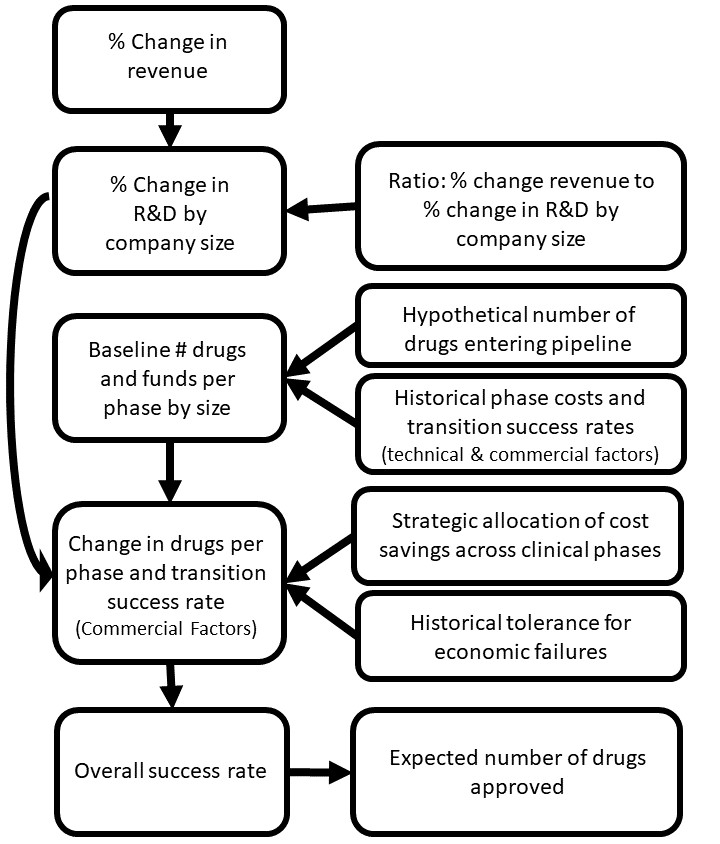Notes
Introduction
This dashboard enables you to model the impact of drug price reductions of 0-20% with differential allocation of cost reductions through phased clinical development.
Model for impact of revenue reductions on new drug approvals
Figure 1: Model Schematic
Assuming revenue-related reduction in R&D spending will impact investment in phased
clinical trials, the progression of candidate therapeutics  is modeled through the development
is modeled through the development
pipeline. The model assumes that companies of different size will reduce R&D spending by different amounts and that cost reduction is achieved by selective allocation of resources to the first three phases of clinical development only. The model incorporates changes in R&D spending proportional to reduction in revenue for companies of different size and the fraction of clinical trials performed by small biopharmaceutical companies.
The model incorporates published data regarding the per drug costs of each clinical phase as well as the phase transition success rate provided.8
A schematic of the model is shown in Figure 1. The model estimates the steady state level of drug approvals for a hypothetical number of candidate products entering clinical development. The model enables consideration of scenarios that embody different levels of revenue reduction and differential allocation of cost savings between phase 1, phase 2, and phase 3 clinical trials.
Table 1 below shows the drug approvals for a baseline case and three scenarios where pharmaceutical revenue is decreased by 10%. The baseline case assumes that 400 candidate compounds enter phase 1 trials in a typical year. Based on reported success rates, 47 of the 400 candidate compounds would be approved. The 10% reduction in global pharmaceutical revenue modeled in this scenario represents approximately a 21% reduction in prices for branded pharmaceuticals in the US market. This estimate is based on branded pharmaceuticals representing 88% of US drug spending and US drug sales representing 48% of global sales.
| Baseline | Scenario 1 | Scenario 2 | Scenario 3 | |
|---|---|---|---|---|
| Phase 1 | 400 | 384 | 400 | 368 |
| cost | $10,120.00 | $9,724.95 | $10,120.00 | $9,306.54 |
| Phase 2 | 238 | 229 | 238 | 222 |
| cost | $13,951.49 | $13,420.64 | $13,951.49 | $13,138.03 |
| Phase 3 | 85 | 81 | 77 | 84 |
| cost | $21,598.16 | $20,716.37 | $19,790.47 | $21,417.39 |
| Approval | 47 | 45 | 43 | 47 |
We note that the model embodies highly conservative assumptions that would tend to be biased towards greater reductions in the number of drug approvals. Specifically, (i) the model uses upper bound values for the likely reduction in R&D expense for each quartile of large companies; (ii) clinical trials involving multiple companies are assigned to the largest company, which exhibit the greatest reduction in R&D expense; (iii) this model assumes that reductions in R&D will be achieved exclusively by decreasing the number of compounds in clinical trials and does not contemplate innovations that might increase the efficiency of pharmaceutical R&D; (iv) the result shown reflects the steady stage level of productivity that would not be achieved for 6-10 years after implementation of price reductions. Any reduction in the number of annual drug approvals would occur gradually, and the real deficit in new drugs over this interval would be less pronounced than estimated at steady state.
References
- Rep. Pallone, F. (2021). Elijah E. Cummings Lower Drug Costs Now Act (H.R.3) https://www.congress.gov/bill/116th-congress/house-bill/3; Sen. Grassley, C. (2019). Prescription Drug Pricing Reduction Act (S.2543) https://www.congress.gov/bill/116th-congress/senate-bill/2543; Sen. Sanders, B. & Rep. Khanna, R. (2021). Prescription Drug Price Relief Act (S.909/H.R.2148) https://www.congress.gov/bill/117th-congress/senate-bill/909; Sen. Sanders, B. & Rep. Doggett, L. (2021). Medicare Drug Price Negotiation Act (S.908/H.R.2139) https://www.congress.gov/bill/117th-congress/senate-bill/908; Sen. Sanders, B. (2021). Affordable and Safe Prescription Drug Importation Act (S.920) https://www.congress.gov/bill/117th-congress/senate-bill/920.
- These data were first described in: Congressional Budget Office. Letter to Honorable Frank Pallone Jr. Chairman Committee on Energy and Commerce U.S. House of Representatives Re: Effects of Drug Price Negotiation Stemming From Title 1 of H.R. 3, the Lower Drug Costs Now Act of 2019, on Spending and Revenues Related to Part D of Medicare, October 11, 2019. https://www.cbo.gov/system/files/2019-10/hr3ltr.pdf. The letter states that the CBO’s “…preliminary estimate is that a reduction in revenues of $0.5 trillion to $1 trillion would lead to a reduction of approximately 8 to 15 new drugs coming to market over the next 10 years.”; The Congressional Budget Office model has been described in: Adams, C. & Herrnstadt, E. (2021). CBO’s Model of Drug Price Negotiations Under the Elijah E. Cummings Lower Drug Costs Now Act: Working Paper 2021-01 (No. 56905). CBO. https://www.cbo.gov/system/files/2021-02/56905-Drug-Price-Negotiations.pdf; These data were quoted in: Austin, D. & Hayford, T. (2021). Research and Development in the Pharmaceutical Industry. CBO. https://www.cbo.gov/system/files/2021-04/57025-Rx-RnD.pdf.
- Ledley, F. D., & Vaughan, G. (2021). Will reducing drug prices slow innovation? https://scholars.bentley.edu/sci_industry/3/.
- Center for Integration of Science and Industry, Bentley University.
- West Health Policy Center.
- Aitken, M., Kleinrock, M., Nass, D. & Simorellis, A. (2019). The Changing Landscape of Research and Development: Innovation, Drivers of Change, and Evolution of Clinical Trial Productivity. IQVIA Institute. https://www.iqvia.com/insights/the-iqvia-institute/reports/the-changing-landscape-of-research-and-development; Quoted in Austin & Hayford 2021, op. cit.
- Please see Table 1 above.
- DiMasi, J. A., Grabowski, H. G. & Hansen, R. W. (2016). Innovation in the pharmaceutical industry: new estimates of R&D costs. Journal of health economics, 47, 20-33. https://www.sciencedirect.com/science/article/abs/pii/S0167629616000291; Wouters, O. J., McKee, M. & Luyten, J. (2020). Estimated research and development investment needed to bring a new medicine to market, 2009-2018. Jama, 323(9), 844-853. https://jamanetwork.com/journals/jama/article-abstract/2762311.
Acknowledgments
This research was funded by the West Health Policy Center and conducted by the Center for Integration of Science and Industry. The dashboard was created with the Data Analytics Research Team at Bentley University with the assistance of the Academic Technology Center.
The Center for Integration of Science and Industry also receives research support from the National Biomedical Research Foundation, Institute for New Economic Thinking, and others.
The authors thank Zheng (Maat) Zeng for constructing the dashboard as well as Guarav Shah and his team at the Academic Technology Center. The authors also thank Sean Dickson (West Health Policy Center) for his support and guidance, Roger Du, Dr. Sarah McCoy, and Kevin Zhang for their contributions to this research, and Juliana Harrison for her many contributions to this project including website construction.

Bentley University is one of the nation's top business schools. It is a lifelong-learning community that trains leaders to make business a force for positive change. With a combination of business and the arts and sciences as well as a flexible, personalized approach to education, Bentley provides students with critical thinking and practical skills that prepare them for successful, rewarding careers. Founded in 1917, the university enrolls 4,200 undergraduate and 1,000 graduate and PhD students and is set on 163 acres in Waltham, Massachusetts,10 miles west of Boston. For more information, visit https://www.bentley.edu and follow us on Twitter @BentleyU #BentleyUResearch.

The Center for Integration of Science and Industry at Bentley University focuses on advancing the translation of scientific discoveries to create public value. The Center is a nexus for broadly interdisciplinary scholarship designed to integrate biomedical science, data analytics, economics, business, and public policy. For more information, visit https://www.bentley.edu/centers/center-for-integration-science-and-industry and follow us on Twitter @sciindustry.

The Data Analytics Research Team is an interdisciplinary group of faculty and researchers dedicated to the exploration and analysis of data sets in an effort to create knowledge and insights. A wide range of analytical and modeling techniques are used to investigate the data sets. To achieve its objectives, our team has focused its energies on projects in the following areas: living standards, marketing analytics, global studies, health care analytics and social networks.

The West Health Policy Center is focused on research and education to identify innovations and policy solutions that can slow the trajectory of rising healthcare costs while improving access to-and the quality of-care, particularly for our nation's growing population of seniors. Specific areas of focus include reducing growth in U.S. spending on prescription drugs, promoting value-based care models, increasing price transparency, and limiting consumer exposure to high out-of-pocket costs. Solely funded by philanthropists Gary and Mary West, the Policy Center is based in Washington, D.C., and is part of West Health, a family of nonpartisan, nonprofit organizations dedicated to lowering the cost of healthcare to enable successful aging. For more information, visit https://www.westhealth.org and follow us on Twitter @WestHealth.



